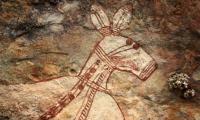One of the world's biggest uranium producers has found a significant deposit in a remote tropical Australian mountain range near sandstone galleries holding some of the oldest and most spectacular rock art on the planet.
After years of drilling, Canadian-based mining company Cameco has reported the find in the Wellington Range, where the thousands of Aboriginal artworks adorning cliffs and caves include a painting of the extinct dog-like creature, the thylacine, made in a style that is at least 15,000 years old.
"The importance of this art site is that it's like a library," Ronald Lamilami, a traditional Aboriginal landowner in western Arnhem Land and a custodian for the art, told The Global Mail, which on Friday published a detailed feature and map of the rock-art sites at risk nationwide. Lamilami said he fears if mining goes ahead, the works of his ancestors will be damaged.
The archaeologist Prof Paul Taçon, who has worked with Lamilami to document and date the artwork, said that dust and visitors from mining exploration could potentially damage works at the Northern Territory's Djulirri, Malarrak and Bald Rock galleries.
Uranium runs right through the Wellington Range area, and Cameco has explored close to Djulirri, although the big deposit found recently is nearer to Australia's northern coast, Taçon said.
Where once there was trenchant opposition to expanding uranium mining in Australia – which has the largest known reserves in the world – the present Labor government has softened its stance, as the resources boom feeding China's voracious appetite for energy powers the Australian economy.
When the Australian prime minister, Julia Gillard, worked through a uranium deal with India late last year, Toronto-based Cameco noted her nation could benefit from a nuclear boom in India and in China.
The company has reportedly been trying to strike a deposit in Australia as rich as that of the Athabasca Basin in its home country, which supplies about one-fifth of the world's uranium.
Djulirri, a magnificent complex where artwork ripples across cliffs, into caves and beneath overhangs, contains more than 3,000 images, including the oldest known "contact" art, a faded yellow ochre depiction of a south-east Asian boat at least 350 years old.
The rainbow serpent, fish, kangaroos and other creatures are painted in traditional "X-ray" style and the world's only known indigenous rock-art stencils depicting whole birds are silhouetted on a cave wall, while the gallery also features European missionaries, a biplane and a buggy.
At nearby Malarrak and Bald Rock galleries, there are more recent images of rifles, a coffee mug, an ocean cruiser and three stencils of a tobacco tin.
"There are rock art sites throughout the Wellington Range, but most of it still has not been adequately surveyed," said Taçon, who worries that the explorers surging across Australia as its resources boom continues will damage works never properly recorded.
There are estimated to be about 100,000 rock-art sites in Australia, with more than one million images, but there is not even a national list, let alone adequate heritage protection, according to Taçon.
Lamilami said his people are not anti-development, but the resources boom has made it apparent that mining will impact both the people and the country in Arnhem Land.
"It's spreading like a wart," he said.
Australia's environment minister, Tony Burke's office said Cameco had not yet submitted a proposal for any uranium project in the Wellington Range, but such a plan would need clearance if it was likely to have significant environmental impact.
Cameco Australia's managing director, Brian Reilly, said that the company would work with all stakeholders to protect the area's environment, culture and heritage.
Traditional owners – the Aboriginal people who own land belonging to their ancestors – review any exploration work by the company, which conducts heritage surveys to ensure these areas are protected, he said.
Meanwhile, an exploration company owned by the world's second richest woman, Gina Rinehart, has just announced that it will withdraw two applications to explore for minerals, after Aboriginal complaints that mining could damage another world-class rock art precinct in northern Queensland.
However, research by James Cook University adjunct research fellow in archaeology Noelene Cole has discovered this region, known as "Quinkan" country, is crisscrossed by similar applications. These have not been lifted.
• Read more about the threats to Aboriginal rock art on The Global Mail.

